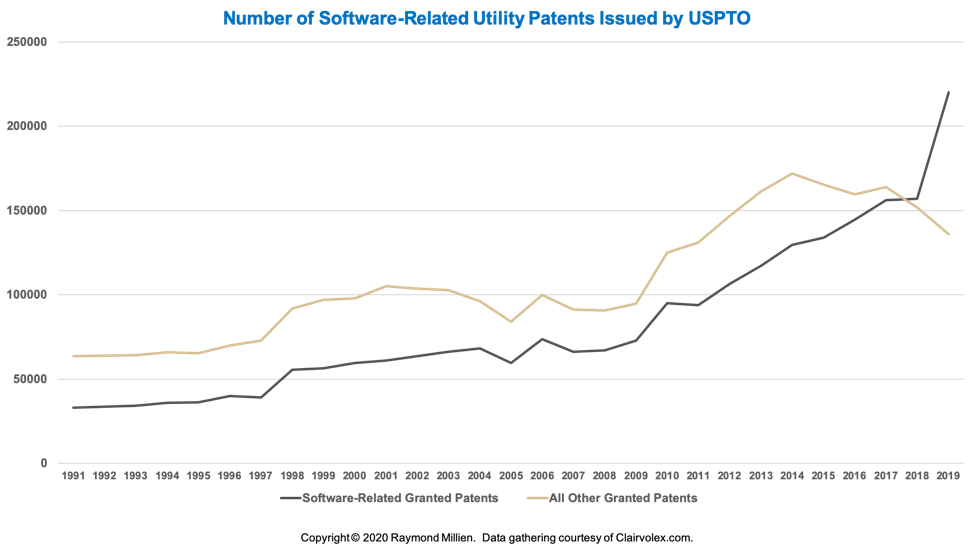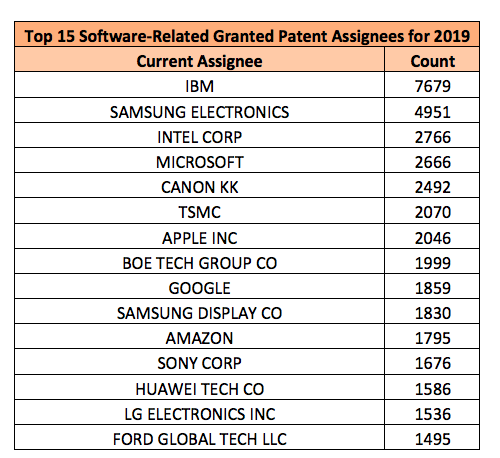 As an update to my posts from 2017 and 2019, it has now been more than six years since the U.S. Supreme Court’s 2014 Alice Corp. v. CLS Bank decision. Still, the IP bar awaits a clear and reliable test to determine when exactly a software (or computer-implemented) claim is patentable versus being simply an abstract idea “free to all men and reserved exclusively to none.”
As an update to my posts from 2017 and 2019, it has now been more than six years since the U.S. Supreme Court’s 2014 Alice Corp. v. CLS Bank decision. Still, the IP bar awaits a clear and reliable test to determine when exactly a software (or computer-implemented) claim is patentable versus being simply an abstract idea “free to all men and reserved exclusively to none.”
The USPTO’s Section 101 guidelines interpreting Alice—and the accompanying 46 examples—have not cleared the confusion, and Alice continues to distract the USPTO, courts, and practitioners from focusing properly on Sections 102 (novelty) and 103 (obviousness). The net effects still being increased cost, lower patent quality, lower patent portfolio valuations, wasted patent reform lobbying dollars and, in many instances, the denial of patent protection for worthwhile software inventions.
Meanwhile, in the real world, which is experiencing the Fourth Industrial Revolution, the importance of software continues to be undeniable:
- The United States is the largest tech market in the world, representing 32% of the total or approximately $1.7 trillion of estimated IT spend, for 2020 [CompTIA].
- In 2019, the global M&A activity in the Software & Internet Services space reached US$206 billion, representing over 3,656 deals [IMAA].
- The employment of software developers is projected to grow 21 percent from 2018 to 2028, much faster than the average for all occupations [U.S. Bureau of Labor Statistics].
- Application software developer was the most in-demand job for 2019, with an annual median salary of US$101,790 and a growth outlook of 31% through 2024 [CNBC].
- In 2018, there were 79,598 Bachelor’s degrees, 46,468 Master’s degrees, and 2,017 Ph.D.’s awarded in the U.S. in computer and information sciences [National Center of Educational Statistics].
- The IoT market is on pace to grow to over US$3 trillion annually by 2026; and by 2025, there will be more than 64 billion IoT devices, up from about 10 billion in 2018 [Business Insider].
- By 2025, 60% of enterprises will deploy code to production at least once per day (up from about 3% today); and by 2023, 30% of the Forbes Global 2000 will be deriving at least 20% of their digital revenue from digital developer ecosystems’ use of their digital services and apps [IDC].
Given these latest facts, I once again sought to determine what percentage of USPTO-issued utility patents are “software-related”? To define what patents are “software-related,” I utilized the same methodology employed by the United States Government Accountability Office in a 2013 report to Congress. That report relied on certain United States Patent Classification (USPC) classes and subclasses of applications most likely to include software-related claims as selected by expert advisors to the USPTO. Now, with the assistance of IP services firm Clairvolex (and after converting data from the USPC system to the Cooperative Patent Classification (CPC) system), the data set was updated. The results? In 2019, 61.8% of issued U.S utility patents were “software-related” (up 21.64% from 2018)!



In sum, the lack of legal clarity surrounding software patents remains counterproductive to the IoT age in which we live.
This post reflects my current personal views and should not be necessarily attributed to my current or former employers, or their respective clients or customers.
Image Source: Deposit Photos
Image ID: 38756235
Copyright: 72soul

![[IPWatchdog Logo]](https://ipwatchdog.com/wp-content/themes/IPWatchdog%20-%202023/assets/images/temp/logo-small@2x.png)

![[Advertisement]](https://ipwatchdog.com/wp-content/uploads/2024/04/Patent-Litigation-Masters-2024-sidebar-700x500-1.jpg)

![[Advertisement]](https://ipwatchdog.com/wp-content/uploads/2021/12/WEBINAR-336-x-280-px.png)
![[Advertisement]](https://ipwatchdog.com/wp-content/uploads/2021/12/2021-Patent-Practice-on-Demand-recorded-Feb-2021-336-x-280.jpg)
![[Advertisement]](https://ipwatchdog.com/wp-content/uploads/2021/12/Ad-4-The-Invent-Patent-System™.png)






Join the Discussion
14 comments so far.
Anon
February 19, 2020 04:27 pmMark,
I have to question the baseline logic of your calculations as to the correlation of spend and value.
I think that you may have some idea — but that THAT idea has not as of yet gestated into a cognitive point.
There may — in fact — NOT be any way to tie “dollars” of an innovation field to patent prosecution dollars. I am not sure that there is even any underlying LOGIC that would dictate that some correlation even NEED exist.
Anon
February 19, 2020 04:23 pmTFCFM,
Your gambit of not paying attention and simply dismissing anything that I say and THEN trying to claim that I have not provided any additional items is a FAIL on its face.
It is lost on no one that you do not provide answers to the direct questions put to you.
Mark Nowotarski
February 19, 2020 01:38 pmInteresting numbers. If you assume a prosecution + inventor time for each issued patent to be about $100k (remember you have to take into account abandoned applications as well), then the total investment in US software related patents is about $20 B/yr. That sounds like a lot, but it’s only about 1% of the $1.7T IT spend. Assuming spend correspond to net value creation, that’s not a big fraction.
The question it raises for me, is “How can be change the design of patents themselves so that they create more value?” (i.e. worth spending more money to invest in) The current design of patents (text based spec, text based claims, line drawings) dates to the early 1800s.
Surely we can do better?
TFCFM
February 19, 2020 10:26 amanon@#9: “You continue to make posts that show that you do not understand patent law or the issues afflicting patent law.”
You, by contrast continue to make posts that merely claim that my opinions are incorrect without remotely attempting to substantively discuss why you so opine.
In future, save yourself and your keyboard the trouble and just reply, “Nuh UHHH!!!”
Concerned
February 18, 2020 12:58 pmName withheld @7:
I guess my point is the method the USPTO uses to rejection my claims, if applied uniformly to Big Tech, IBM would have zero patents.
I can make unsubstantiated statements on every invention known to mankind. I can concede every invention solved a great problem and then arbitrarily state no practical application on the invention. I can eliminate 75% of the claims of my choice to deny all patents. I can say everyone does an invention when it’s obvious and proved nobody does the invention. And I can say it automated a manual process when not showing one example of alleged manual process.
So how did IBM get so many inventions to pass “go” if these impossible conditions were applied equally to them?
Anon
February 18, 2020 12:34 pmTFCFM,
You still just do not get it.
The statement of “beginning to figure out the contours of ‘software-related’ subject matter that is, and is not, patent-eligible under current law. is a logical non sequitur to the amount of items processed through the USPTO (items which not only may, but in a very real sense, have a HIGH likelihood OF being turned to dust in the post grant world.
You continue to make posts that show that you do not understand patent law or the issues afflicting patent law.
Pro Say
February 18, 2020 11:15 amExcellent point Concrned @ 5: If IBM’s name was on your app, you would indeed have your patent.
Sadly for us and our 1,000’s of independent inventor brethren, we are not IBM . . . or Apple . . . or Google . . . or Facebook . . . or any other big tech company.
And excellent point angry dude @ 3: “In this day and age pretty much everything is “computer-implemented” and “software-related”….”
Name withheld to protect the innocent
February 18, 2020 11:11 amFor those discussing IBM patents, I suggest you look at the prosecution history of the issued patents for IBM. I highly doubt you’ll find many first action allowances.
From my experience, the USPTO craps on applicants of all sizes. The difference between the small guy and an entity like IBM, is that the small guy has 1 or 2 applications currently being examined. IBM, I’m guessing, has tens of thousands.
TFCFM
February 18, 2020 10:55 amRM: “61.8% of U.S. Patents Issued in 2019 Were ‘Software-Related’—up 21.6% from 2018”
To me, this observation seems directly contrary to the author’s contention:
RM: “In sum, the lack of legal clarity surrounding software patents remains counterproductive to the IoT age in which we live.”
A 20% jump in the proportion of patents that are ‘software-related’ seems to me an unmistakably clear sign that both patent examiners and patent practitioners are beginning to figure out the contours of ‘software-related’ subject matter that is, and is not, patent-eligible under current law.
Dreams that one magical, simple test will provide pin-point, black-and-white clarity as to eligibility for the entire range of ‘software-related’ subject matter seem to be just that: dreams — dreams that will not be fulfilled.
Intelligent patent practitioners and examiners (as well as the courts) are figuring out the contours of patent eligibility, even as the federal courts and legislature continue to struggle with how best to express those contours.
Concerned
February 18, 2020 01:01 amApparently IBM cannot receive unsubstantiated rejections, cannot receive rejections with court cases regarding Mars and cannot receive rejections on “That a boy” accomplishments.
One of IBM’s 7,679 patents must have been an anti-BS zapper and it must have been filed first before the other 7,678 of them. Shortly thereafter the others on the author’s list of big tech must have borrowed that zapper from IBM so their inventions would get the wink and nod.
I wonder if I refiled my exact same invention and showed IBM as the inventor if I would even get a 102 or 103 rejection? Maybe IBM would accidentally send me $20-30k and a wall plaque as IBM runs around trying to figure out where their “Captain Tuttle” is employed within their organization?
angry dude
February 17, 2020 10:02 pmconcerned @1
Because you are not IBM
IBM’s “bestest inventors of the year” don’t sleep, don’t eat, don’t poop – they just file junk patents all day, every day and night too…
For that they get the IBM medal or some wall plaque I guess .. but no extra money… maybe 20-30K at the most … for being the bestest of the bestest ibm inventor
Same with other large tech corps – i talked to lots of those corporate “inventors” – they hate this sh1t – almost no gain for them, just hassle
angry dude
February 17, 2020 09:44 pmDude,
In this day and age pretty much everything is “computer-implemented” and “software-related”…. except the Bunch-o-Balloons and a few other things
Pro Say
February 17, 2020 08:44 pmWe caused Section 101 / eligibility uncertainty, you say?
“See no evil. Hear no evil. Speak much evil.”
— SCOTUS
concerned
February 17, 2020 07:54 pmHow can IBM get 7679 patents in 2019 and I cannot even get one? It is a rhetorical question.
All I get are unsubstantiated rejections, court cases that the examiner admits in writing are not in my field and acknowledgment that it solved a very long standing problem.
IBM “7679”. Me “zero”. Amazing.